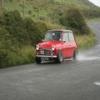
Brake Master Cylinder Options
#16

Posted 31 January 2011 - 04:51 PM
#17

Posted 31 January 2011 - 05:29 PM
#18

Posted 31 January 2011 - 07:13 PM
Does that make any sense at all and does anyone know where I'm coming from??!
#19

Posted 31 January 2011 - 11:58 PM
One might think that you could actually mount the valve inside the car under the rear seat panel so that it is not adjustable by the driver whilst seated in the car. In fact, the MoT tester would not see it if it was mounted behind a drop-down panel screwed in place and that would probably then meet the regulations.
Personally I like a servo on a rally car and when I tried my 'S' without one I found that they lacked feel and then tended to grab. That was with carbon-metallic race pads and 7.5" discs in the wet. In fact, whilst testing it I nearly spun it! Re-fitted the servo straight after I got back to the workshop.
#20

Posted 01 February 2011 - 07:49 AM
#21

Posted 03 February 2011 - 09:56 PM
If so thats why I wasn't sure about using a regulator in one line, i.e. if you limit the pressure then the pedal goes harder without travelling so far, does it not prevent full pressure being exerted on the fronts which are mechanically linked to the same piston on the MC?
Good remark.
That mean you regulate the pressure in all the system (front and rear). Thinking this way, it sounds scary.
As people tried that system already, i guess something must be wrong with your reflection, but i cannot see what
#22

Posted 04 February 2011 - 11:12 PM
#23

Posted 05 February 2011 - 12:54 AM
Regarding dual masters - there are 2 pistons in the same bore with fluid in between them (connected to one of the circuits). If all's well, the brake linings will limit the travel at the wheels and keep enough fluid between the pistons to hold them apart & there will be equal force on either side of the upper piston and it'll behave like a single piston cylinder that just happens to have 2 outlets. If you have a yellow band cylinder, the upper piston has a smaller diameter on top than below, the forces on the piston are still equal but the upper cylinder is at a higher pressure by virtue of the smaller piston area.
The higher pressure gives more power to the front brakes. If you hooked the circuits up the wrong way round there'd be more pressure in the rear line for the under pressured front line to cut off in the brake limiter valve = spinning Mini.
If you're rallying it'd be well worth considering an inertia valve to control the brake balance - they work by the weight transfer to the front rather than line pressure, so compensate for going up 'n down hill as well as road grip.
#24

Posted 05 February 2011 - 01:10 AM
I guess the yellow tag type must have a spring or something in between to softly link pistons so you can bleed them up etc, with 4 pot front calipers would I not be better off with equal sized pistons as the extra area in the calipers should provide the extra pressure, and a smaller master piston would increase pedal travel (especially with 4 pots) would it not? If this is the case, what type could I look for which doesn't have biased sizes?
Also I'm not sure on the inertia valve, they seem like a good idea but if they were that good then nobody would have manual bias valves, and about every rally car I've seen has a manual one, and I do see them every day!
#25

Posted 05 February 2011 - 10:28 AM
#26

Posted 05 February 2011 - 01:07 PM
1 user(s) are reading this topic
0 members, 1 guests, 0 anonymous users















